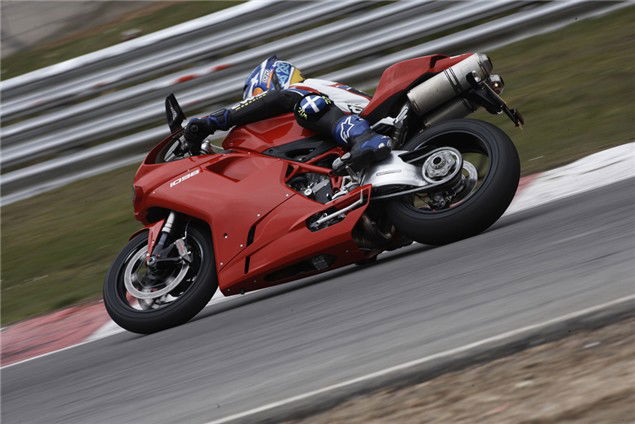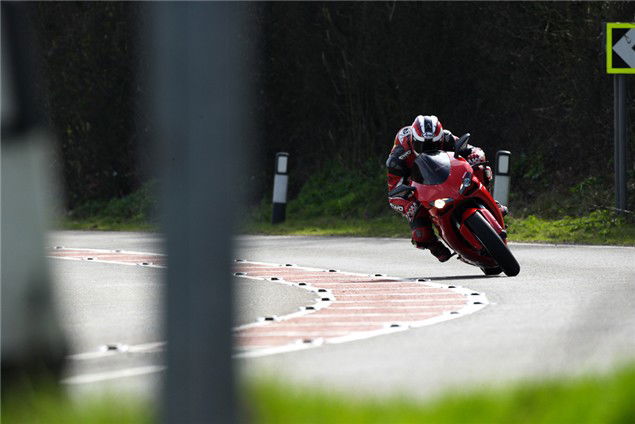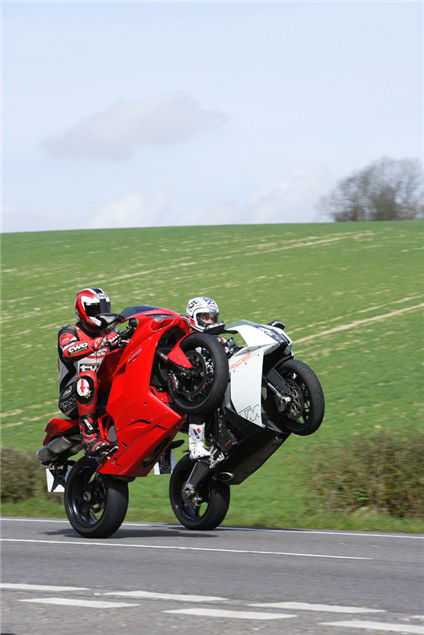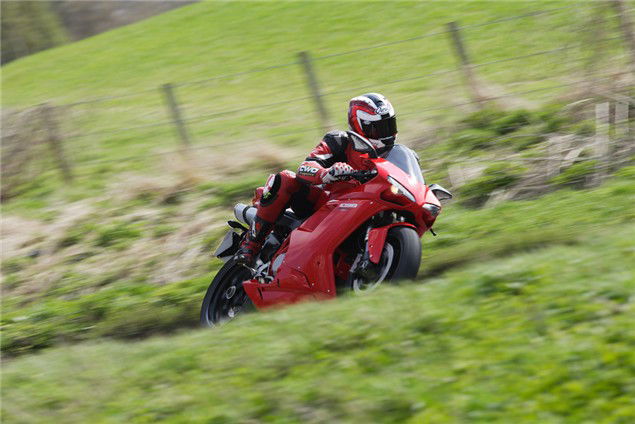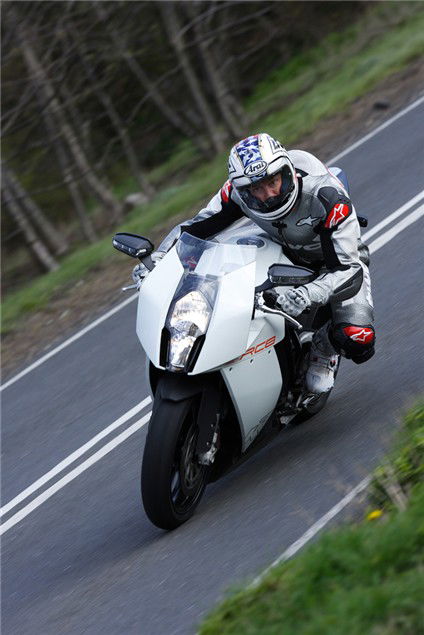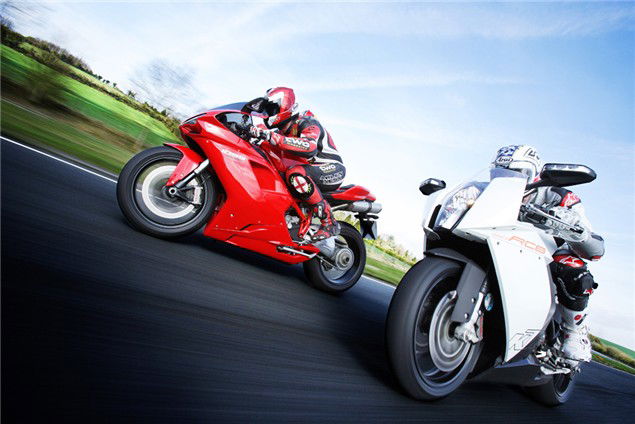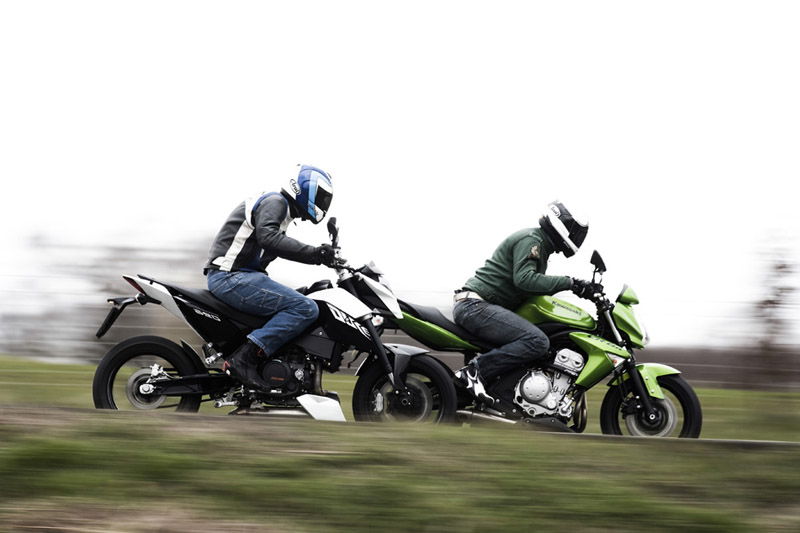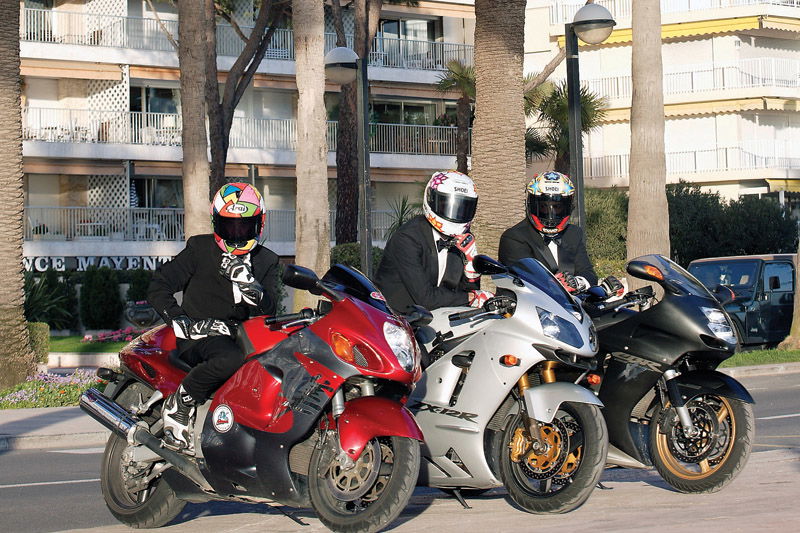KTM RC8 vs. Ducati 1098 - Euro Fighters
KTM's plan could be seen as audacious; take on the benchmark boss, Ducati’s 1098. So, should Ducati be scared?

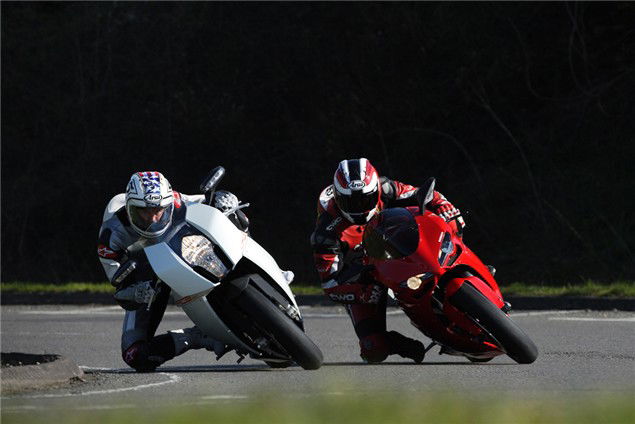
The end of a very long road is in sight, and I’m actually quite nervous. In my hand I have the key to the beautiful, yet slightly menacing-looking white bike that sticks out from the row of Japanese sportsbikes it currently nestles within. I’m about to get closure on a journey I started nearly a year ago, yet I’m terrified the experience won’t live up to my expectations.
About eight months previously I was standing in KTM’s R&D department at the firm’s factory in Austria looking at this bike, but back then it was little more than a test mule. The fairing was black, it didn’t have any clocks and from every nook and cranny random wires hung out, feeding an array of sensors. Sworn to silence I was one of the first people outside the factory to see the final version of the RC8, and I was blown away. The bike’s designers, like proud parents, showed me around their baby pointing out the features such as the adjustable pegs, bars and sub-frame, explaining that this was a bike designed by riders for riders. They even started it up, and the small room was filled with the booming sound of the V-twin engine. But they wouldn’t let me ride it.
Then, just before Christmas last year, I was back at the factory, this time with the full blessing of everyone involved to tell the whole world how this bike made it from the drawing board to the final production machine. Again a ride on an RC8 was tantalisingly close, but again my helmet stayed in the back of the car. So now is my time.
Turning the key in the ignition the chunky square dash glows into life and bombards me with a startling array of numbers. Fuel trip, trip distance, trip time, revs, speed, I don’t know where to look. What happened to good old-fashioned speed and revs? Now the moment of truth, I push the starter button and the RC8 barks into life.
It doesn’t sound or feel like I was expecting. The engine note has a distinct rattle about it while blipping the throttle to get some heat into the motor the bike feels rough and raw. Where Japanese fours whirr and spin when you blip them this bike snarls and clatters. With a solid clunk I engage first and head home.
After a few miles my dreams are lying on the floor, broken into tiny pieces. Maybe I was expecting too much, but the experience I’ve waited so long for just isn’t what I envisioned. I don’t know, having ridden all of KTM’s other twins I was expecting a smooth revving engine packed with punch that doesn’t so much as gently entice you into having fun, more grabs you by the balls and insists on it. The RC8’s motor feels and rides just like it sounds, rough and raw. Accelerating hard brings with it a wonderful barking exhaust note, but also a barrage of vibrations. It’s absolutely nothing like the smooth flow of power from the 990 engine and nothing like what I was expecting, and then there’s the gearbox. Cantlie came back from the bike’s launch saying the RC8 had some gearbox issues, and he isn’t wrong. Our bike only had about 300 miles on the clock so things were still bedding in but a very firm foot is required to change gears and the box doesn’t like being rushed. Try a fast shift from first to second or second to third (generally on the back wheel it has to be said) and you get a clatter of cogs, a rise of revs and no gear. Take you time and it engages positively, but it’s far from a slick operation. By the time I reached my house I was left frustrated and slightly flat, I hadn’t clicked in the way I was expecting with the RC8 and, in a word, I was gutted.
The next morning I woke up feeling slightly better about matters. V-twins always take a little while to click with, maybe we had just got off to a bad start. I was sure today would be better, the weather was great and waiting for a back to back comparison was a Ducati 1098, the benchmark V-twin ever since it was launched.
Riding over to WM Snell, the Ducati dealer who had generously agreed to lend us the 1098 for the day, I started to feel a bit better about the RC8. Riding it for a longer period of time I was relishing the surprisingly roomy riding position that dispels the myth that for sporty handling you need a stance that resembles the kind of pose you have to adopt to get your prostate checked, but a few more irritations raised their ugly heads. I’ve ridden a few 1098s before so I know their mirrors are crap, you don’t need to ride the bike to know this, just one look at them tells you they are purely there to tick a box for the vehicle inspectorate, but the KTM’s look like they should be fantastic. Unfortunately the vibrations from the engine make them about as much use as the Ducati’s, and then there’s the lap-time switch. KTM has put a plastic flap over the handlebar mounted lap time switch. A great touch that makes it quick and easy to swap the RC8 dash’s mode, but I kept catching the flap when I went for the indicators, flicking it up and blocking my thumb’s path to the controls, which was deeply irritating. Then, halfway along the A3 the fuel trip started counting down, telling me I was on reserve. After 15 miles it said I had 0 miles (worst case) or 15 miles (best case) left in the tank, which was a bit worrying. Pulling up at a petrol station I opened the tank to be greeted by a hiss as the tank de-pressurised and only managed to fit 11-litres in the 16.5 litre tank. I think a breather pipe could be needed here, KTM.
We reached the Ducati dealer and for the first time got the chance to see the two bikes side by side. Parked next to each other the KTM and Ducati are at completely opposite ends of the design spectrum. The Ducati has clean, flowing lines that blend into each other while keeping a very close link to the classic 916 look. The KTM is angular, pointy and distinct. The shape of things to come next to a design icon brought up to date.
Having ridden the KTM to the dealer I let Cantlie take over KTM duties while I re-acquainted myself with the 1098. After the RC8’s roomy riding position, sitting on the Ducati instantly felt cramped and hard on the wrists and just backing it out of a parking spot the extra weight was noticeable. Although Ducati claim a weight of 173kg it’s much closer to 200kg with fuel, which is about the same as the RC8, but the KTM carries its bulk better. I reckon a lot of it is due to clever positioning of the heavy exhaust. Ducati has been forced to follow the styling of the 916 and stick its weighty pipes, complete with catalysers, under the seat where KTM has been able to hide its low under the engine. This moves the bike’s centre of gravity lower, making it feel lighter.
Turn the Ducati’s key and you are presented with a beautiful clean dash. A large 1098 logo gently scrolls across the display before it clears and a huge rev counter and speedo are shown. Simple, clear, uncluttered and all you need, I like it a lot
Close your eyes, push the starter and it’s pure Ducati. A slight rattle from the dry clutch and a deep thudding growl from the twin pipes. How can two similar engine configurations sound so different? The KTM rattles and sounds rough, the Ducati sounds refined and ready. Which is exactly how it rides.
Within a few feet you know the Ducati riding experience will be very different to the KTM’s one. Maybe it’s because the average Ducati riders age is higher, or possibly because the bike has matured so much in its 14-year life span, but whatever the cause the 1098’s engine now feels a phenomenally refined and smooth motor.
It’s still blisteringly quick, but it delivers the power in a fashion that is a complete contrast to the aggressive KTM. The initial fuelling on the Ducati is about as perfect as you can get. Big V-twins are notoriously tricky to get the fuel injection right on (did someone say Honda SP-1?) but Ducati have it licked. Where the KTM’s power kicks in fairly hard and with a jerk going from a closed to partially open throttle the Ducati’s torque floats in, no jerk, no jump, just lots of grunt. And when it does come in it’s so powerful. The 1098 is lower geared than the KTM, which makes the power appear to come in harder and the bike accelerate faster, and in the first few gears the Ducati is a bit of a handful. Not aggressive and rattly like the KTM, but just very fast and abrupt power that will easily lift the front wheel under acceleration, but it does it with control.
The RC8 tends to explode its power in a flurry of revs, the 1098 delivers it with restraint and without the engine feeling like it is working. The exhaust note hardly seems to change, there are certainly no vibrations to give the game away, just strong, hard helpings of torque delivered wave after wave. It’s a beautiful engine that is easy to live with yet more than capable of going completely mental when the need arises, such as when you are out on one of the best days this year.
KTM RC8
Price: £10,695
Engine: 1,148cc, liquid-cooled, dOHC, 8-valve V-twin
Power: 132.9bhp @ 9,100rpm
Torque: 83.1lb.ft @ 6,700rpm
Front suspension: 43mm WP uSD, FULLY-adj
Rear suspension: WP monoshock, FULLY adj
Front brake: 320mm disc, four-piston calipers
Rear brake: 220mm disc, two-piston caliper
Dry weight: 188kg (claimed)
Seat height: 805mm
Fuel capacity: 16.5l
Top speed: 167.4mph
Colours: orange, white
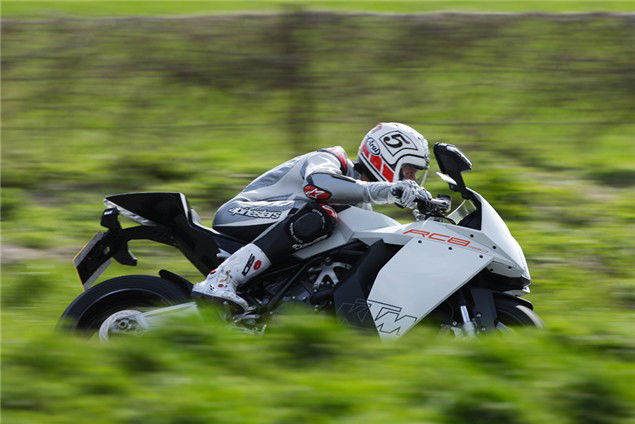
RC8 vs. 1098 verdict
A few miles out of town we reached a road that is obviously a bit of a favourite for local bikers with fast flowing corners, perfect for these two bikes. Suddenly the Ducati felt long and slow to turn after the KTM. It’s surprising how much difference there is between the two bikes when it comes to the handling, because in stock trim the KTM blows the Ducati away when it comes to speed of turn. Ducatis always seem to come setup very low at the back, making them slightly resistive to initial turn in, lazy almost, and the 1098 is no exception. On a track when you can be more aggressive and muscle the bike around it’s not as pronounced but on the road, and certainly compared to the RC8, the Ducati felt a bit ponderous.
The pay off for this is superb mid-corner balance, but the RC8 manages to combine fast turn-in with a Ducati matching mid-corner poise. KTM know how to make a good chassis and combined with the beautiful WP suspension the RC8’s handling is fantastic, helped by the riding position. Because the RC8 is roomier its much easier to move around the bike, hang off and generally get yourself settled for a corner compared to the 1098’s restrictive riding position. Going fast on the RC8 is less physically demanding than on the Ducati and it feels as though KTM has made a big effort to give the RC8 as light and sporty handling as possible, something it has succeeded with. And a set of serious stoppers to match.
The power of the brakes on the KTM is very impressive, one-finger jobs, which John loved. I preferred the Ducati’s set-up, which was more progressive, but if you want s topping power the KTM has it in abundance.
Swapping back to the KTM for my journey home having spent most of the day on the 1098 it again felt rough and raw. I’m not a huge fan of the slightly over the top brakes but there is no doubting the roomy riding position and light handling make it feel a far better handling bike on the road than the Ducati, but I couldn’t help but find myself missing the beautiful engine and gearbox from the 1098 every time I found another noisy false neutral.
Over the next few days the various pros and cons of the RC8 compared to the 1098 were the subject of much debate in the office, but at the end of the day it boils down to one factor, which would you spend the best part of £11,000 on? When it comes to this the answer is simple: the Ducati. KTM has produced a stunning bike with the RC8 that handles better than the 1098 and looks spellbinding. But it is a bike at the start of its development process and, dare I say it, almost one that has been launched a year too early. It simply has too many rough edges. The gearbox is horrific and although the engine makes a tremendous amount of power its vibrations are intrusive. Then there are the little things such as the mirrors vibrating, silly lap switch, pressurising fuel tank, cluttered dash, all small irritations that should have been ironed out before the bike was launched.
The Ducati, in contrast, is very hard to pick faults with, especially with the overall finish. The 1098 is not only classically beautiful, it works. The engine has all the grunt you could ever need, a super-slick gearbox and only has the rattle of a dry clutch when you want it, stationary when people will be looking at you. The handling might be a bit slower than the KTM, the riding position more cramped and the brakes a bit blunter but this is a bike that feels, and is, thoroughly developed. As Niall said, in a few year’s time the RC8 will almost certainly kick the arse out of the Ducati, it’s a bike at the start of its life rather than one that has just been through a mid-life crisis and is now getting on a bit, but that doesn’t help today’s buyer. Yes, there is the argument that the KTM is rough and raw because that’s the kind of character KTM’s customer wants in their bike, but when you ride the two bikes back to back this rough edge isn’t fun, it’s quite annoying.
For a first attempt at a superbike the KTM is stunning and remember how many teething problems Ducati had with the original 916. But the RC8 isn’t quite the polished article yet, the 1098 is.
CANTLIE RECKONS - KTM
Rough, ready and typically KTM, that’s how the RC8 feels after the 1098. The tall first gear is just stupidly tall, the gearbox is as horrible as I remember, but the bike is small and light and goes like stink. After the Ducati it feels half the weight and steers like a racebike. Regardless of how much speed you carry into a corner, the KTM can be stopped and turned while the Ducati is still wondering where to go.
The Brembo set-up on the RC8 has far more instant bite and power (which I like) and being 6’2” I can move around naturally on the KTM, which I can’t on the cramped 1098. All it took was 10mins on the Ducati to get uncomfortable, whereas you could ride the RC8 all day and not get saddle-sore. So, what have we got there? The 1098’s engine is obviously better, but it’s had nearly two decades of development on it. Out the box the KTM stops and turns quicker, and its looks are futuristic while the Ducati is rounded and sexy. The KTM is a Yorkshire terrier to the Ducati’s Rhodesian Ridgeback.
CANTLIE RECKONS - DUCATI
I have to admit, this was the first time I’d ever ridden a 1098 in any guise. The engine is glorious, a deep-throated, power-laden version of the 998R motor I used to love so much in 2000, and the way it builds revs is incredible. From just about any rpm the Ducati punches forward with blistering haste, all the while accompanied by an exhaust note to die for.
In this respect, the Ducati is streets ahead of the KTM. The engine shows its 15 years of refinement with a slick, precise gearbox and a liquid smoothness that the Austrian bike simply cannot touch. But elsewhere, it seems fairly obvious to me that the Ducati is reaching the end of its development life. It’s heavy, doesn’t turn (although this can of course be dialled out with more rear ride-height) and from some angles it just looks plain old-fashioned. Which, of course, is part of its appeal to many riders.
Jumping on it after the KTM (a bike I’m pretty familiar with now) I was like, “this is the bike you’d buy.” But then I thought about it and wasn’t so sure – the KTM is right at the start of its development cycle and there’s a great deal more future in the RC8 than the Ducati.
MACKENZIE TRACK OPINIONS
I have to admit, this was the first time I’d ever ridden a 1098 in any guise. The engine is glorious, a deep-throated, power-laden version of the 998R motor I used to love so much in 2000, and the way it builds revs is incredible. From just about any rpm the Ducati punches forwards, all the while accompanied by an exhaust note to die for.
In this respect, the Ducati is streets ahead of the KTM. The engine shows its 15 years of refinement with a slick, precise gearbox and a liquid smoothness that the Austrian bike simply cannot touch. But elsewhere, it seems fairly obvious to me that the Ducati is reaching the end of its development life. It’s heavy, doesn’t turn (although this can of course be dialled out with more rear ride-height) and from some angles it just looks plain old-fashioned. Which, of course, is part of its appeal to many riders.
Jumping on it after the KTM (a bike I’m pretty familiar with now) I was like, “this is the bike you’d buy.” But then I thought about it and wasn’t so sure – the KTM is right at the start of its development cycle and there’s a great deal more future in the RC8 than the Ducati.
DUCATI 1098
Price: £11,250
Engine: 1099cc, liquid-cooled, dOHC, 8-valve V-twin
Power: 141.2bhp @ 9,400rpm
Torque: 81.0lb.ft @ 7,800rpm
Front suspension: USD showa FULLY-adj
Rear suspension: Monoshock showa FULLY adj
Front brake: 330mm disc, four-piston calipers
Rear brake: 245mm disc, two-piston caliper
Dry weight: 173kg (claimed)
Seat height: 820mm
Fuel capacity: 15.5l
Top speed: 170.1mph
Colours: red, yellow
